JUnit5學習之一:基本操作
阿新 • • 發佈:2021-02-19
### 歡迎訪問我的GitHub
[https://github.com/zq2599/blog_demos](https://github.com/zq2599/blog_demos)
內容:所有原創文章分類彙總及配套原始碼,涉及Java、Docker、Kubernetes、DevOPS等;
### 關於《JUnit5學習》系列
《JUnit5學習》系列旨在通過實戰提升SpringBoot環境下的單元測試技能,一共八篇文章,連結如下:
1. [基本操作](https://blog.csdn.net/boling_cavalry/article/details/108810587)
2. [Assumptions類](https://blog.csdn.net/boling_cavalry/article/details/108861185)
3. [Assertions類](https://blog.csdn.net/boling_cavalry/article/details/108899437)
4. [按條件執行](https://blog.csdn.net/boling_cavalry/article/details/108909107)
5. [標籤(Tag)和自定義註解](https://blog.csdn.net/boling_cavalry/article/details/108914091)
6. [引數化測試(Parameterized Tests)基礎](https://blog.csdn.net/boling_cavalry/article/details/108930987)
7. [引數化測試(Parameterized Tests)進階](https://blog.csdn.net/boling_cavalry/article/details/108942301)
8. [綜合進階(終篇)](https://blog.csdn.net/boling_cavalry/article/details/108952500)
### 本篇概覽
本文是《JUnit5學習》系列的第一篇,通過實戰學習在SpringBoot框架下JUnit5的基本功能,全篇章節如下:
1. JUnit5簡介
2. SpringBoot對JUnit5的依賴
3. 常用註解簡介
4. 5版本已廢棄的註解介紹
5. 進入實戰環節,先介紹版本和環境資訊
6. 建立《JUnit5學習》系列原始碼的父工程
7. 建立子工程,編碼體驗常用註解
### 關於JUnit5
1. JUnit是常用的java單元測試框架,5是當前最新版本,其整體架構如下(圖片來自網路):
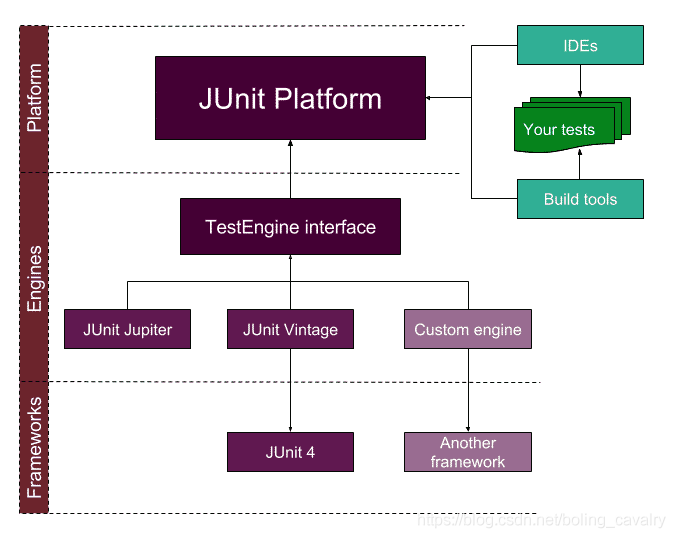
2. 從上圖可見,整個JUnit5可以劃分成三層:頂層框架(Framework)、中間的引擎(Engine),底層的平臺(Platform);
3. 官方定義JUnit5由三部分組成:Platform、Jupiter、Vintage,功能如下;
4. Platform:位於架構的最底層,是JVM上執行單元測試的基礎平臺,還對接了各種IDE(例如IDEA、eclipse),並且還與引擎層對接,定義了引擎層對接的API;
5. Jupiter:位於引擎層,支援5版本的程式設計模型、擴充套件模型;
6. Vintage:位於引擎層,用於執行低版本的測試用例;
- 可見整個Junit Platform是開放的,通過引擎API各種測試框架都可以接入;
### SpringBoot對JUnit5的依賴
1. 這裡使用SpringBoot版本為2.3.4.RELEASE,在專案的pom.xml中依賴JUnit5的方法如下:
```xml
```
2. 如下圖紅框,可見JUnit5的jar都被spring-boot-starter-test間接依賴進來了:
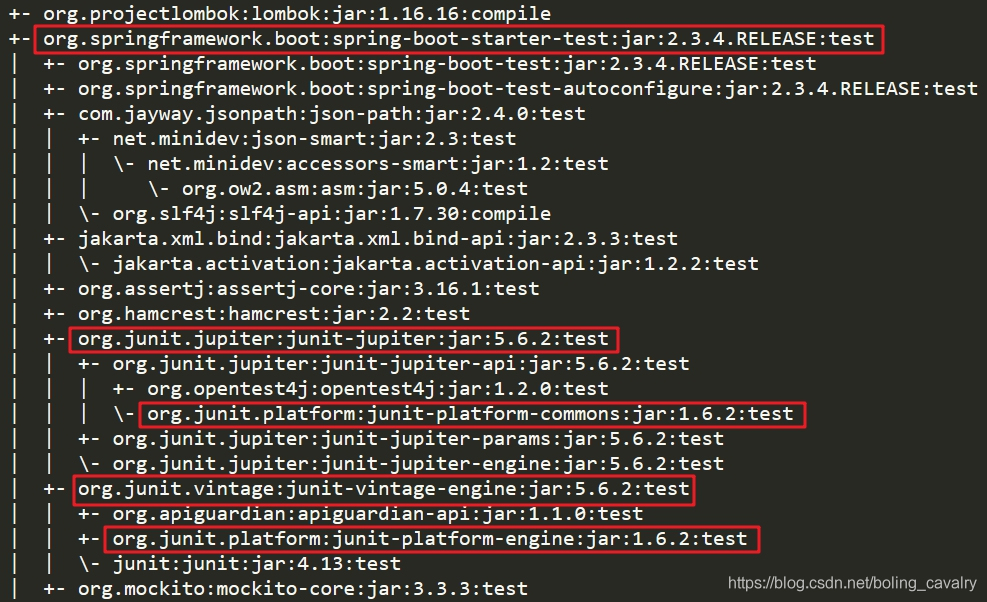
### 曾經的RunWith註解
1. 在使用JUnit4的時候,咱們經常這麼寫單元測試類:
```java
@RunWith(SpringRunner.class)
@SpringBootTest
public class XXXTest {
```
2. 對於上面的RunWith註解,JUnit5官方文件的說法如下圖紅框所示,已經被ExtendWith取代:

3. 咱們再來看看SpringBootTest註解,如下圖,可見已經包含了ExtendWith:

4. 綜上所述,SpringBoot+JUnit5時,RunWith註解已經不需要了,正常情況下僅SpringBootTest註解即可,如果對擴充套件性有更多需求,可以新增ExtendWith註解,如下圖:
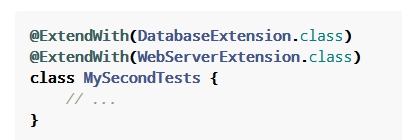
### 常用的JUnit5註解(SpringBoot環境)
注意,接下來提到的測試方法,是指當前class中所有被@Test、@RepeatedTest、@ParameterizedTest、@TestFactory修飾的方法;
1. ExtendWith:這是用來取代舊版本中的RunWith註解,不過在SpringBoot環境如果沒有特別要求無需額外配置,因為SpringBootTest中已經有了;
2. Test:被該註解修飾的就是測試方法;
3. BeforeAll:被該註解修飾的必須是靜態方法,會在所有測試方法之前執行,會被子類繼承,取代低版本的BeforeClass;
4. AfterAll:被該註解修飾的必須是靜態方法,會在所有測試方法執行之後才被執行,會被子類繼承,取代低版本的AfterClass;
5. BeforeEach:被該註解修飾的方法會在每個測試方法執行前被執行一次,會被子類繼承,取代低版本的Before;
6. AfterEach:被該註解修飾的方法會在每個測試方法執行後被執行一次,會被子類繼承,取代低版本的Before;
7. DisplayName:測試方法的展現名稱,在測試框架中展示,支援emoji;
8. Timeout:超時時長,被修飾的方法如果超時則會導致測試不通過;
9. Disabled:不執行的測試方法;
### 5版本已廢棄的註解
以下的註解都是在5之前的版本使用的,現在已經被廢棄:
| 被廢棄的註解 | 新的繼任者 |
|--|--|
| Before | BeforeEach |
| After | AfterEach |
| BeforeClass | BeforeAll |
| AfterClass | AfterAll |
| Category | Tag |
| RunWith | ExtendWith |
| Rule | ExtendWith |
| ClassRule | RegisterExtension |
### 版本和環境資訊
整個系列的編碼和執行在以下環境進行,供您參考:
1. 硬體配置:處理器i5-8400,記憶體32G,硬碟128G SSD + 500G HDD
2. 作業系統:Windows10家庭中文版
3. IDEA:2020.2.2 (Ultimate Edition)
4. JDK:1.8.0_181
5. SpringBoot:2.3.4.RELEASE
6. JUnit Jupiter:5.6.2
接下來開始實戰,咱們先建好SpringBoot專案;
### 關於lombok
為了簡化程式碼,專案中使用了lombok,請您在IDEA中安裝lombok外掛;
### 原始碼下載
1. 如果您不想編碼,可以在GitHub下載所有原始碼,地址和連結資訊如下表所示(https://github.com/zq2599/blog_demos):
| 名稱 | 連結 | 備註|
| :-------- | :----| :----|
| 專案主頁| https://github.com/zq2599/blog_demos | 該專案在GitHub上的主頁 |
| git倉庫地址(https)| https://github.com/zq2599/blog_demos.git | 該專案原始碼的倉庫地址,https協議 |
| git倉庫地址(ssh)| [email protected]:zq2599/blog_demos.git | 該專案原始碼的倉庫地址,ssh協議 |
2. 這個git專案中有多個資料夾,本章的應用在junitpractice資料夾下,如下圖紅框所示:

3. junitpractice是父子結構的工程,本篇的程式碼在junit5experience子工程中,如下圖:
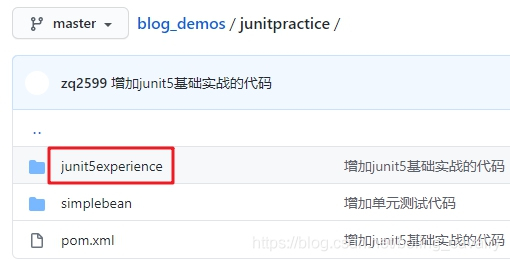
### 建立Maven父工程
1. 為了便於管理整個系列的原始碼,在此建立名為junitpractice的maven工程,後續所有實戰的原始碼都作為junitpractice的子工程;
2. junitpractice的pom.xml如下,可見是以SpringBoot的2.3.4.RELEASE版本作為其父工程:
```xml
```
### 本篇的原始碼工程
接下來咱們準備一個簡單的SpringBoot工程用於做單元測試,該工程有service和controller層,包含一些簡單的介面和類;
1. 建立名為junit5experience的子工程,pom.xml如下,注意單元測試要依賴spring-boot-starter-test:
```xml
```
2. 寫一些最簡單的業務程式碼,首先是service層的介面HelloService.java:
```java
package com.bolingcavalry.junit5experience.service;
public interface HelloService {
String hello(String name);
int increase(int value);
/**
* 該方法會等待1秒後返回true,這是在模擬一個耗時的遠端呼叫
* @return
*/
boolean remoteRequest();
}
```
3. 上述介面對應的實現類如下,hello和increase方法分別返回String型和int型,remoteRequest故意sleep了1秒鐘,用來測試Timeout註解的效果:
```java
package com.bolingcavalry.junit5experience.service.impl;
import com.bolingcavalry.junit5experience.service.HelloService;
import org.springframework.stereotype.Service;
@Service()
public class HelloServiceImpl implements HelloService {
@Override
public String hello(String name) {
return "Hello " + name;
}
@Override
public int increase(int value) {
return value + 1;
}
@Override
public boolean remoteRequest() {
try {
Thread.sleep(1000);
} catch (InterruptedException interruptedException) {
interruptedException.printStackTrace();
}
return true;
}
}
```
4. 新增一個簡單的controller:
```java
package com.bolingcavalry.junit5experience.controller;
import com.bolingcavalry.junit5experience.service.HelloService;
import org.springframework.beans.factory.annotation.Autowired;
import org.springframework.web.bind.annotation.PathVariable;
import org.springframework.web.bind.annotation.RequestMapping;
import org.springframework.web.bind.annotation.RequestMethod;
import org.springframework.web.bind.annotation.RestController;
@RestController
public class HelloController {
@Autowired
private HelloService helloService;
@RequestMapping(value = "/{name}", method = RequestMethod.GET)
public String hello(@PathVariable String name){
return helloService.hello(name);
}
}
```
5. 啟動類:
```java
package com.bolingcavalry.junit5experience;
import org.springframework.boot.SpringApplication;
import org.springframework.boot.autoconfigure.SpringBootApplication;
@SpringBootApplication
public class Junit5ExperienceApplication {
public static void main(String[] args) {
SpringApplication.run(Junit5ExperienceApplication.class, args);
}
}
```
- 以上就是一個典型的web工程,接下來一起為該工程編寫單元測試用例;
### 編寫測試程式碼
1. 在下圖紅框位置新增單元測試類:
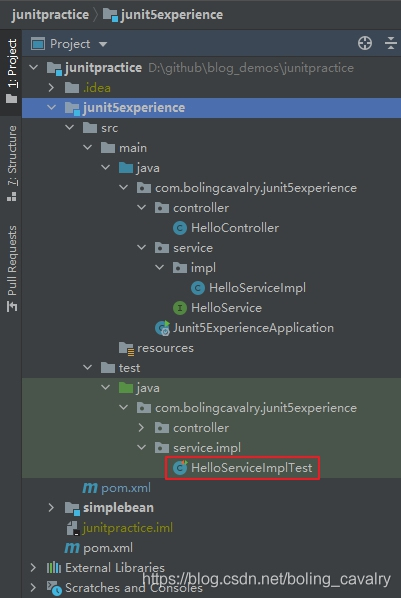
2. 測試類的內容如下,涵蓋了剛才提到的常用註解,請注意每個方法的註釋說明:
```java
package com.bolingcavalry.junit5experience.service.impl;
import com.bolingcavalry.junit5experience.service.HelloService;
import lombok.extern.slf4j.Slf4j;
import org.junit.jupiter.api.*;
import org.springframework.beans.factory.annotation.Autowired;
import org.springframework.boot.test.context.SpringBootTest;
import java.util.concurrent.TimeUnit;
import static org.assertj.core.api.Assertions.assertThat;
@SpringBootTest
@Slf4j
class HelloServiceImplTest {
private static final String NAME = "Tom";
@Autowired
HelloService helloService;
/**
* 在所有測試方法執行前被執行
*/
@BeforeAll
static void beforeAll() {
log.info("execute beforeAll");
}
/**
* 在所有測試方法執行後被執行
*/
@AfterAll
static void afterAll() {
log.info("execute afterAll");
}
/**
* 每個測試方法執行前都會執行一次
*/
@BeforeEach
void beforeEach() {
log.info("execute beforeEach");
}
/**
* 每個測試方法執行後都會執行一次
*/
@AfterEach
void afterEach() {
log.info("execute afterEach");
}
@Test
@DisplayName("測試service層的hello方法")
void hello() {
log.info("execute hello");
assertThat(helloService.hello(NAME)).isEqualTo("Hello " + NAME);
}
/**
* DisplayName中帶有emoji,在測試框架中能夠展示
*/
@Test
@DisplayName("測試service層的increase方法\uD83D\uDE31")
void increase() {
log.info("execute increase");
assertThat(helloService.increase(1)).isEqualByComparingTo(2);
}
/**
* 不會被執行的測試方法
*/
@Test
@Disabled
void neverExecute() {
log.info("execute neverExecute");
}
/**
* 呼叫一個耗時1秒的方法,用Timeout設定超時時間是500毫秒,
* 因此該用例會測試失敗
*/
@Test
@Timeout(unit = TimeUnit.MILLISECONDS, value = 500)
@Disabled
void remoteRequest() {
assertThat(helloService.remoteRequest()).isEqualTo(true);
}
}
```
3. 接下來執行測試用例試試,點選下圖紅框中的按鈕:

4. 如下圖,在彈出的選單中,點選紅框位置:
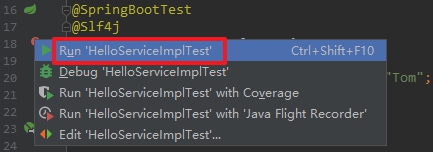
5. 執行結果如下,可見Displayname註解的值作為測試結果的方法名展示,超時的方法會被判定為測試不通過,Disable註解修飾的方法則被標記為跳過不執行:

6. 在父工程junitpractice的pom.xml檔案所在目錄,執行mvn test命令,可以看到maven執行單元測試的效果:
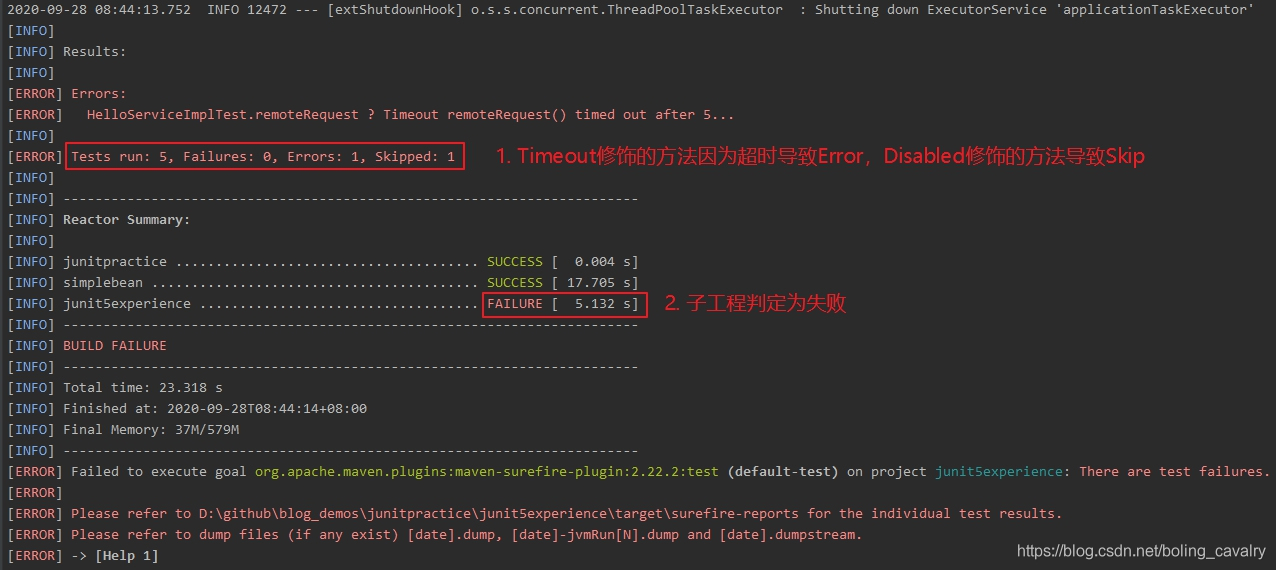
- 至此,咱們對SpringBoot環境下的JUnit5有了最基本的瞭解,接下來的章節會展開更多知識點和細節,對單元測試做更深入的學習。
### 你不孤單,欣宸原創一路相伴
1. [Java系列](https://xinchen.blog.csdn.net/article/details/105068742)
2. [Spring系列](https://xinchen.blog.csdn.net/article/details/105086498)
3. [Docker系列](https://xinchen.blog.csdn.net/article/details/105086732)
4. [kubernetes系列](https://xinchen.blog.csdn.net/article/details/105086794)
5. [資料庫+中介軟體系列](https://xinchen.blog.csdn.net/article/details/105086850)
6. [DevOps系列](https://xinchen.blog.csdn.net/article/details/105086920)
### 歡迎關注公眾號:程式設計師欣宸
> 微信搜尋「程式設計師欣宸」,我是欣宸,期待與您一同暢遊Java世界...
[https://github.com/zq2599/blog_demos](https://github.com/zq2599/blog_demos)
